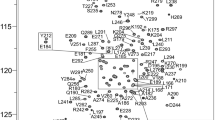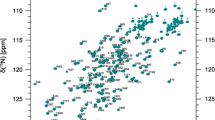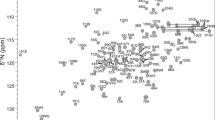Abstract
The natural transformation system of the thermophilic bacterium Thermus thermophilus is one of the most efficient DNA transport systems in terms of DNA uptake rate and promiscuity. The DNA transporter of T. thermophilus plays an important role in interdomain DNA transfer in hot environments. PilF is the traffic ATPase that provides the energy for the assembly of the DNA translocation machinery and the functionally linked type IV pilus system in T. thermophilus. In contrast to other known traffic ATPases, the N-terminal region of PilF harbors three consecutive domains with homology to general secretory pathway II (GSPII) domains. These GSPII-like domains influence pilus assembly, twitching motility and transformation efficiency. A structural homolog of the PilF GSPII-like domains, the N-terminal domain of the traffic ATPase MshE from Vibrio cholerae, was recently crystallized in complex with the bacterial second messenger c-di-GMP. In order to study the consequences of c-di-GMP binding on the three-dimensional architecture of PilF, we initiated structural studies on the PilF GSPII-like domains. Here, we present the 1H, 13C and 15N chemical shift assignments for the isolated PilF GSPII-C domain from T. thermophilus in complex with c-di-GMP. In addition, the structural dynamics of the complex was investigated in an {1H},15N-hetNOE experiment.



Similar content being viewed by others
References
Averhoff B (2009) Shuffling genes around in hot environments: the unique DNA transporter of Thermus thermophilus. FEMS Microbiol Rev 33(3):611–626
Collins RF, Hassan D, Karuppiah V, Thistlethwaite A, Derrick JP (2013) Structure and mechanism of the PilF DNA transformation ATPase from Thermus thermophilus. Biochem J 450(2):417–425
Collins R, Karuppiah V, Siebert CA, Dajani R, Thistlethwaite A, Derrick JP (2018) Structural cycle of the Thermus thermophilus PilF ATPase: the powering of type IVa pilus assembly. Sci Rep 8(1):14022
Farrow NA, Muhandiram R, Singer AU, Pascal SM, Kay CM, Gish G, Shoelson SE, Pawson T, Forman-Kay JD, Kay LE (1994) Backbone dynamics of a free and phosphopeptide-complexed Src homology 2 domain studied by 15N NMR relaxation. Biochemistry 33(19):5984–6003
Favier A, Brutscher B (2011) Recovering lost magnetization: polarization enhancement in biomolecular NMR. J Biomol NMR 49(1):9–15
Jones CJ, Utada A, Davis KR, Thongsomboon W, Zamorano Sanchez D, Banakar V, Cegelski L, Wong GCL, Yildiz FH (2015) C-di-GMP regulates motile to sessile transition by modulating MshA pili biogenesis and near-surface motility behavior in Vibrio cholerae. PLoS Pathog 11(10):e1005068
Keller RLJ (2004) The computer aided resonance assignment tutorial. CANTINA Verlag, Goldau
Keller H, Weickhmann AK, Bock T, Wöhnert J (2018) Adenine protonation enables cyclic-di-GMP binding to cyclic-GAMP sensing riboswitches. RNA 24(10):1390–1402
Koyama Y, Hoshino T, Tomizuka N, Furukawa K (1986) Genetic transformation of the extreme thermophile Thermus thermophilus and of other Thermus spp. J Bacteriol 166(1):338–340
Kruse K, Salzer R, Averhoff B (2018a) The traffic ATPase PilF interacts with the inner membrane platform of the DNA translocator and type IV pili from Thermus thermophilus. FEBS Open Bio 9(1):4–17
Kruse K, Salzer R, Joos F, Averhoff B (2018b) Functional dissection of the three N-terminal general secretory pathway domains and the Walker motifs of the traffic ATPase PilF from Thermus thermophilus. Extremophiles 22(3):461–471
Lescop E, Schanda P, Brutscher B (2007) A set of BEST triple-resonance experiments for time-optimized protein resonance assignment. J Magn Reson 187(1):163–169
Markley JL, Bax A, Arata Y, Hilbers CW, Kaptein R, Sykes BD, Wright PE, Wüthrich K (1998) Recommendations for the presentation of NMR structures of proteins and nucleic acids. IUPAC-IUBMB-IUPAB Inter-Union Task Group on the standardization of data bases of protein and nucleic acid structures determined by NMR spectroscopy. J Biomol NMR 12(1):1–23
Muchmore DC, McIntosh LP, Russell CB, Anderson DE, Dahlquist FW (1989) Expression and nitrogen-15 labeling of proteins for proton and nitrogen-15 nuclear magnetic resonance. Methods Enzymol 177:44–73
Pardi A, Nikonowicz EP (1992) Simple procedure for resonance assignment of the sugar protons in carbon-13 labeled RNAs. J Am Chem Soc 114(23):9202–9203
Rose I, Biuković G, Aderhold P, Müller V, Grüber G, Averhoff B (2011) Identification and characterization of a unique, zinc-containing transport ATPase essential for natural transformation in Thermus thermophilus HB27. Extremophiles 15(2):191–202
Salzer R, Herzberg M, Nies DH, Joos F, Rathmann B, Thielmann Y, Averhoff B (2014a) Zinc and ATP binding of the hexameric AAA-ATPase PilF from Thermus thermophilus: role in complex stability, piliation, adhesion, twitching motility, and natural transformation. J Biol Chem 289(44):30343–30354
Salzer R, Joos F, Averhoff B (2014b) Type IV pilus biogenesis, twitching motility, and DNA uptake in Thermus thermophilus: discrete roles of antagonistic ATPases PilF, PilT1, and PilT2. Appl Environ Microbiol 80(2):644–652
Sattler M (1999) Heteronuclear multidimensional NMR experiments for the structure determination of proteins in solution employing pulsed field gradients. Prog Nucl Magn Reson Spectrosc 34(2):93–158
Schubert M, Labudde D, Oschkinat H, Schmieder P (2002) A software tool for the prediction of Xaa-Pro peptide bond conformations in proteins based on 13C chemical shift statistics. J Biomol NMR 24(2):149–154
Schwarzenlander C, Averhoff B (2006) Characterization of DNA transport in the thermophilic bacterium Thermus thermophilus HB27. FEBS J 273(18):4210–4218
Shen Y, Bax A (2013) Protein backbone and sidechain torsion angles predicted from NMR chemical shifts using artificial neural networks. J Biomol NMR 56(3):227–241
Sklenár V, Peterson RD, Rejante MR, Feigon J (1993) Two- and three-dimensional HCN experiments for correlating base and sugar resonances in 15N,13C-labeled RNA oligonucleotides. J Biomol NMR 3(6):721–727
Solyom Z, Schwarten M, Geist L, Konrat R, Willbold D, Brutscher B (2013) BEST-TROSY experiments for time-efficient sequential resonance assignment of large disordered proteins. J Biomol NMR 55(4):311–321
Wang Y-C, Chin K-H, Tu Z-L, He J, Jones CJ, Sanchez DZ, Yildiz FH, Galperin MY, Chou S-H (2016) Nucleotide binding by the widespread high-affinity cyclic di-GMP receptor MshEN domain. Nat Commun 7:12481
Wendler P, Ciniawsky S, Kock M, Kube S (2012) Structure and function of the AAA + nucleotide binding pocket. Biochim Biophys Acta 1823(1):2–14
Acknowledgements
We are very grateful to Stefanie Düsterhus for expert help with sample preparation. This work was supported by the Deutsche Forschungsgemeinschaft (DFG) through grant AV9/6-2 to BA and Wo 901/7-1 to JW. Grant Wo901/7-1 is part of the DFG special focus program SPP 1879 ‘Nucleotide Second Messenger Signaling in Bacteria’. The Center for Biomolecular Magnetic Resonance (BMRZ) at the Goethe University Frankfurt is generously supported by the state of Hesse.
Author information
Authors and Affiliations
Corresponding authors
Additional information
Publisher's Note
Springer Nature remains neutral with regard to jurisdictional claims in published maps and institutional affiliations.
Rights and permissions
About this article
Cite this article
Keller, H., Kruse, K., Averhoff, B. et al. NMR resonance assignments for the GSPII-C domain of the PilF ATPase from Thermus thermophilus in complex with c-di-GMP. Biomol NMR Assign 13, 361–366 (2019). https://doi.org/10.1007/s12104-019-09906-w
Received:
Accepted:
Published:
Issue Date:
DOI: https://doi.org/10.1007/s12104-019-09906-w




